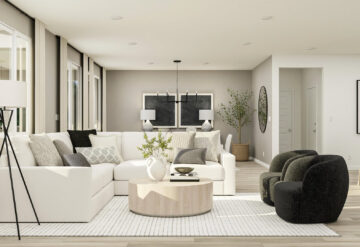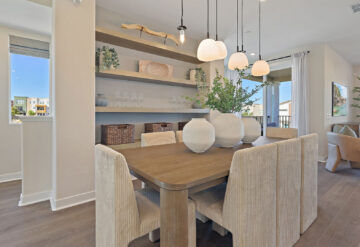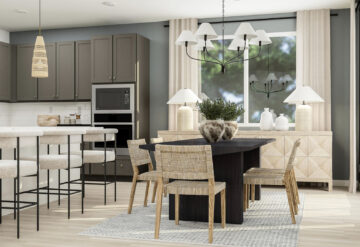Children grow up so quickly, and their interests evolve at a rapid pace. Designing and decorating your child’s room every few years to reflect his or her changing personality and dynamic hobbies can be time-consuming and expensive. You want your child’s room to reflect who they are; be a comfortable, fun, and clearly personal space; but, still hold a timeless style that is practical throughout their formative and teenage years. Here are six interior design tips to help you achieve a timeless kids’ room, one that will grow with your son(s) and/or daughter(s) until they venture out on their own.
Flexible Furnishings

When selecting furniture for your child’s room, keep this single rule in mind: Simple equals flexible. Themed furnishings with intricate designs (e.g., racecar beds, indoor forts, and animal chairs) are fun for a youngster of 4 to 7 years, but the inevitable teenager will want more “grown-up” fittings for when friends come over; therefore, you should purchase pieces with simple lines and good proportions.
Acquire furniture that functions over an extended period, from your child’s toddler to teen years. Daybeds accommodate 4+ children and appealingly imitate the look of a sofa in the daytime; better yet, a trundle daybed makes for convenient sleepovers. Choosing full-sized bureaus and nightstands over child-sized dressers allows for the storage of a growing wardrobe, and adjustable activity tables and stools can be raised to new heights as your child gains stature. You and your child can also benefit from the use of convertible furniture such as cribs that transform into full-size beds or changing tables that convert into desks.

The furniture you use in your child’s room should be movable, able to be properly placed within the space so as not to inhibit your child from being active. Investing in quality furniture ensures longevity; durable, cleanable materials like natural woods and ironwork can withstand the roughhousing kids dish out, which relieves you of any concern about replacing a part of or whole piece of furniture in a few years. Moreover, neutral-colored furnishing materials, like oak wood, complement varying room designs and color schemes.
Additional Sources:
How to Choose Kid’s Room Furniture that You’ll Both Love by Ronique Gibson
How to Choose Kids’ Room Furniture that You’ll Both Love by Christina Dennis
Wood: Top Material Used for Kids’ Room Furniture
Using Metal Furniture in Baby, Kids, and Teen Rooms
Storage Space
Kids tend to gather a lot of belongings (e.g., toys, clothes, books, school supplies, etc.), and they need somewhere to store everything, or you risk yourself a tripping hazard. A mix of open- and closed-storage ideas allows a room to appear spacious, but still display beautiful, colorful items that add personality to the room. A storage bench or antique trunk at the foot of the bed are closed-storage solutions with vintage flair, while a bookcase with a pegboard nailed to the back visually organizes a child’s collection(s) of toys and/or personal items.
Additional Sources:
15 Real Life Storage Solutions for Kids Rooms
10 Genius Storage Ideas for Your Kid’s Room
Neutral Color Scheme

A guiding principle for painting any room is too many colors make a space seem smaller and visually cluttered. For your child’s room, instead of the stereotypical gender colors that later become an eyesore, apply neutral colors – two or three shades – that are soft and subtle. Gray and beige are soft, muted hues, or you can apply basic white or black paint to make for a lively space once you add colorful accents throughout the room. An example: Does your daughter love purple? You can accessorize the interior of her white-walled room with purple-toned pillows, curtains, bed covers, and hanging artwork to appeal to her taste. If you really want to incorporate your child’s favorite color into the paint job though, and simultaneously make the room “pop,” paint one wall the vibrant color and the three remaining walls a neutral tone; this way, when your son or daughter decides they do not love that color anymore, you only have one wall to cover up.
Additional Sources:
How to Choose Paint Color When Decorating Kids’ Rooms
8 Paint Colors Perfect for a Kids’ Room Refresh
The 12 Best Paint Colors for a Kids’ Rooms
Patterns

The inclusion of patterns, be they stripes, polka-dots, or stamped images, in a room’s design can stimulate a subtle feeling of order and balance. Colorful patterns on rugs, bed covers, and/or furniture cushions compliment a room’s neutral tones, add a tinge of warmth to a space; some interior design experts say that the balanced integration of patterns in a child’s room encourages creativity. Too many patterns can be visually chaotic and dizzying; therefore, it is best to limit yourself to the use of three variably-sized patterns – one large, one medium, and one small – such as harlequin diamonds on a single wall, a striped throw rug, and a heart-stamped quilt. Mixing patterns does not have to be scary; the combination of three different patterns can be atheistically pleasing if color unites them.
Additional Sources:
How to Mix Kids’ Room Patterns
8 Ways to Decorate Kids’ Rooms with Geometric Patterns
Soft Lighting

Lighting is a commonly overlooked element in the design of a child’s room when in fact it is important to the functionality of the space. How well do you function in a dimly-lit space? Not very well, right? Your son and/or daughter needs ample lighting in their room to support late-night homework sessions, pre-bedtime reading, and of course playtime. Dim rooms strain the eyes, but the right lighting can make a closed space appear warm and comforting, even stimulate brain activity for problem solving and outbursts of creativity.
There are three types of lighting – ambient, task, and accent. Experts recommend a blend of multiple light sources to create a more inviting interior, one your child will want to use regularly. Ambient lighting pertains to ceiling-mounted and recessed fixtures that emit a warm glow throughout the room, while task lighting refers to features of increased illuminance, such as desk lamps or bedside sconces, that help one achieve specific tasks like reading or studying; you will want both ambient and task lighting features in your child’s room. Accent lighting is optional and includes wall sconces, recessed lights, and track lighting angled to highlight certain articles in a room, like a painting or collection of keepsakes.
Additional Sources:
Lighting Ideas for Your Kids’ Room
Practical Magic: How to Have Great Lighting in The Kids’ Room
Reflect Their Personality

Your child needs to feel that their room is in fact their room; it should express with visual design elements who occupies the space. If your child is an aspiring artist, like most 5+ youths are, give them a place to display their work. Run a string with clothespins along a wall to make a unique, interactive border of their pictures; then, as your son or daughter grows older, he/she can switch out their drawings with postcards, birthday notes, and other personal mementoes. Another option available to you is to create a mini art gallery on a designated wall space using different sized and colored frames to display your child’s masterpieces amongst personal photographs and wall décor.
Go the extra mile in encouraging your son or daughter’s creativity by painting one wall of their room with chalkboard paint. This allows your child to draw on an indestructible surface that is easy to clean and affords a great deal more space than several sheets of paper put together. Also, as your child moves up in school, this chalkboard wall proves useful for late-night homework sessions.
Finally, let’s say you and your child want a more intricate design applied to the walls. Perhaps your six-year-old son really likes dinosaurs, but you do not want to spend the time, energy, or money it takes to paint dinosaurs along the walls of your son’s room, especially when you know he will outgrow this fascination in a few years. The solution is wall decals. These easy-to-remove vinyl stickers come in a variety of sizes and subjects, and some manufacturers will even generate custom orders, including your child’s name in a stylish font or a blown-up family portrait.
Additional Sources:
21 Ways to Display Kids Artwork
7 Tips for Applying Chalkboard Paint
30 Fun Chalkboard Paint Ideas for Kids Room
The Coolest Wall Decals for Kids’ Rooms
If possible, consider involving your son or daughter in the redesign of their room’s interior. You want them to feel comfortable and delighted with their designated area of the home, so bring them with you to pick out colors, furniture, and fabrics; also, investigate your child’s interests to help you choose accessories and design motifs. This is a rare opportunity for you to bond with your child over a large-scale project that directly affects their life at home; make the most of it.
Sources:
How to Design and Decorate A Kids’ Room That Grows With Them by Sherry Nothingam
How to Design a Bedroom that Grows with Your Child by Tara Mastroeni
5 Tips to Designing a Timeless Kids Bedroom by Emily Henderson




